
EGYPTIAN JOURNAL OF ANAESTHESIA
Scope & Guideline
Pioneering Anesthesia Research for a Pain-Free Future
Introduction
Aims and Scopes
- Regional Anaesthesia Techniques:
The journal emphasizes the development and evaluation of various regional anaesthesia techniques, such as the erector spinae plane block and quadratus lumborum block, showcasing their efficacy in pain management across diverse surgical procedures. - Postoperative Pain Management:
A core area of research includes studies on postoperative pain management strategies, particularly the use of multimodal analgesia and opioid-sparing techniques to enhance recovery and reduce complications. - Anaesthesia in Special Populations:
There is a consistent focus on anaesthesia practices in special populations, including pediatric patients, elderly patients, and those with comorbidities, addressing the unique challenges and considerations in these groups. - Critical Care and Monitoring:
The journal highlights advances in critical care monitoring, including hemodynamic monitoring and the use of biomarkers for predicting outcomes in critically ill patients, indicating its commitment to improving care in intensive settings. - Innovative Anesthetic Agents and Techniques:
Research on innovative anesthetic agents, such as dexmedetomidine and their combinations with traditional agents, is frequently presented, reflecting the journal's emphasis on enhancing safety and efficacy in anesthesia. - Educational and Training Aspects in Anaesthesia:
The journal also addresses educational approaches and training programs for anaesthesia professionals, particularly in light of challenges posed by events like the COVID-19 pandemic.
Trending and Emerging
- Opioid-Sparing Techniques:
There is a significant trend towards exploring opioid-sparing techniques for pain management, as seen in the increased research on regional anaesthesia and multimodal analgesia strategies that aim to reduce reliance on opioids. - Enhanced Recovery After Surgery (ERAS) Protocols:
The focus on ERAS protocols has grown, reflecting an emerging interest in optimizing perioperative care to improve patient outcomes, shorten recovery times, and enhance overall surgical experiences. - Application of Ultrasound in Anaesthesia:
The use of ultrasound-guided techniques in anaesthesia is increasingly prominent, with ongoing research into its applications for various blocks and its role in improving accuracy and reducing complications. - Impact of COVID-19 on Anaesthesia Practice:
The journal has seen a rise in studies examining the impact of the COVID-19 pandemic on anaesthesia practices, education, and outcomes, highlighting the need for adaptability in the face of global health challenges. - Biomarkers in Critical Care:
Emerging research on the use of biomarkers for predicting outcomes in critical care settings is gaining traction, indicating a trend towards personalized medicine and better prognostic tools. - Telemedicine and Remote Monitoring:
Recent publications hint at the increasing relevance of telemedicine and remote monitoring in anaesthesia, especially in the context of the pandemic, reflecting a shift towards integrating technology in patient management.
Declining or Waning
- Traditional General Anaesthesia Techniques:
The usage of traditional general anaesthesia techniques has seen a decline, with a noticeable shift towards regional anaesthesia and multimodal approaches, suggesting a move away from solely general anaesthesia in favor of more targeted pain management strategies. - Invasive Monitoring Techniques:
There appears to be less emphasis on traditional invasive monitoring techniques in anaesthesia, as newer non-invasive methods gain traction, reflecting a broader trend towards minimizing invasiveness in clinical practice. - Pharmacological Interventions:
While pharmacological interventions remain important, there is a waning focus on older agents and combinations that have been widely used in the past, as newer agents and protocols are increasingly preferred. - Postoperative Complications Studies:
Research specifically targeting postoperative complications, particularly in non-critical populations, is less frequent, indicating a potential shift towards preventive measures and enhanced recovery protocols rather than post hoc evaluations.
Similar Journals
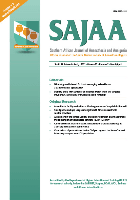
Southern African Journal of Anaesthesia and Analgesia
Exploring the Frontiers of Anesthesia and Pain MedicineThe Southern African Journal of Anaesthesia and Analgesia, published by MEDPHARM PUBLICATIONS PTY LTD, serves as a vital resource in the field of anesthesiology and pain medicine, particularly within the South African context. With an ISSN of 2220-1181 and E-ISSN 2220-1173, this journal has established itself as a significant platform for disseminating research from 2008 through to 2024, boasting a Q3 quartile ranking in anesthesiology and pain management for the year 2023. Although currently listed as non-open access, the journal aims to bridge the gap between innovative clinical practices and evidence-based research. Researchers, healthcare professionals, and students will find in this journal a repository of cutting-edge studies, reviews, and case reports that cater to the evolving needs of the field. Its trajectory within the Scopus ranks, placing it at rank #97 out of 136 in the category, underscores its commitment to advancing the science and practice of anesthesia in Africa and beyond.
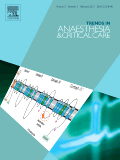
Trends in Anaesthesia and Critical Care
Advancing knowledge in anesthesiology and critical care.Trends in Anaesthesia and Critical Care, published by ELSEVIER SCI LTD, is a pivotal journal in the fields of anesthesiology, pain medicine, and critical care, providing a comprehensive platform for the dissemination of innovative research and clinical advancements. With an ISSN of 2210-8440 and an E-ISSN of 2210-8467, this journal boasts a notable presence in the academic landscape, holding a respectable Q3 ranking in both anesthesiology and critical care categories as of 2023. The journal caters to a diverse audience of researchers, practitioners, and students seeking to stay abreast of the latest trends and breakthroughs from its inception in 2011 until 2024. While it is not an open access journal, its rigorous peer-review process ensures that all published articles meet the highest academic standards, making it a trusted resource for evidence-based practices in anesthesiology and critical care management. As the landscape of these vital medical fields continues to evolve, Trends in Anaesthesia and Critical Care remains an indispensable resource, fostering a community dedicated to enhancing patient outcomes through scholarly exchange.

ACTA ANAESTHESIOLOGICA BELGICA
Advancing Anesthesia: Bridging Research and PracticeACTA ANAESTHESIOLOGICA BELGICA, ISSN 0001-5164, is a prestigious academic journal published by ACTA MEDICAL BELGICA, dedicated to the field of anesthesiology and pain medicine. Established in the 1950s, this journal has continued to serve as a vital platform for disseminating innovative research and evidence-based practices within the discipline. Though currently positioned in the Q4 quartile in both Anesthesiology and Pain Medicine categories, it still plays a significant role in advancing knowledge and bridging gaps related to anesthesia techniques, outcomes, and patient safety. The journal is available in both print and electronic formats, with an E-ISSN of 2736-5239. Operating from Brussels, Belgium, ACTA ANAESTHESIOLOGICA BELGICA fosters an inclusive community of researchers, clinicians, and students, all dedicated to enhancing patient care and safety through the sharing of impactful findings and clinical insights.
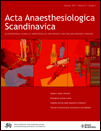
ACTA ANAESTHESIOLOGICA SCANDINAVICA
Exploring Innovative Techniques for Enhanced Patient CareACTA ANAESTHESIOLOGICA SCANDINAVICA, published by Wiley, is a leading journal in the field of anesthesiology and pain medicine, boasting an impressive impact factor evident by its Q1 classification in 2023. As a highly respected publication with a history dating back to 1957 and continuing through to 2024, it serves as a vital platform for researchers and practitioners in Denmark and worldwide to disseminate significant findings and innovative practices in anesthetic techniques and pain management. The journal holds a commendable rank of #45 out of 136 in the Scopus category for Anesthesiology and Pain Medicine, positioning it within the 67th percentile, underlining its substantial contribution to the scientific community. Although not an Open Access journal, ACTA ANAESTHESIOLOGICA SCANDINAVICA remains pivotal for academics and healthcare professionals keen on advancing the field through peer-reviewed research and insightful reviews. Researchers and scholars are encouraged to submit their original studies and reviews to continue enriching this prestigious journal’s commitment to excellence in anesthesiology.

Minerva Anestesiologica
Exploring the Frontiers of Anesthesia and Pain MedicineMinerva Anestesiologica, published by EDIZIONI MINERVA MEDICA, is a premier journal in the field of anesthesiology and pain medicine, with a commendable impact factor and classified in the second quartile (Q2) for 2023. Since its inception in 1953, this esteemed journal has served as a vital resource for researchers, clinicians, and students, presenting high-quality peer-reviewed articles that address a wide range of topics within the domain of anesthesiology. With its current ranking of #42 out of 136 in the Scopus database, Minerva Anestesiologica is recognized for its contribution to advancing clinical practices and innovations in pain management, furthering the knowledge base and professional development in anesthesiology. Although the journal is not open access, it provides comprehensive accessibility options for institutions and individual practitioners, ensuring that critical research is disseminated widely. As it continues to thrive, Minerva Anestesiologica remains a cornerstone of knowledge and a platform for transformative dialogue in the evolving landscape of anesthetic care.

ANESTHESIA AND ANALGESIA
Leading the Way in Anesthesia and Pain Relief ResearchANESTHESIA AND ANALGESIA, published by Lippincott Williams & Wilkins, stands as a pivotal journal in the field of anesthesiology and pain medicine, aiming to advance scientific knowledge and clinical practice since its inception in 1957. This esteemed journal boasts an impressive Q1 ranking in its category, sitting at the 6th position out of 136 in the Scopus rankings, placing it within the top 5% of its field. With an emphasis on delivering high-quality, peer-reviewed research, ANESTHESIA AND ANALGESIA serves as a vital resource for researchers, practitioners, and students alike, offering insights into the latest advancements and methodologies in pain management and anesthesia. The journal is committed to fostering a deeper understanding of these critical areas of medicine, ensuring that its content is accessible to a diverse audience, and despite not offering open access, provides comprehensive coverage of transformative clinical practices and innovations. The journal's address, located at TWO COMMERCE SQ, 2001 MARKET ST, PHILADELPHIA, PA 19103, reflects its establishment within a hub of medical research and education in the United States.
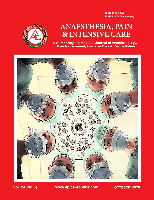
Anaesthesia Pain & Intensive Care
Elevating standards in pain management and anesthesiology.Anaesthesia Pain & Intensive Care is an esteemed, open-access journal that has been at the forefront of disseminating pivotal research since 1999. Published by ANAESTHESIA PAIN & INTENSIVE CARE, this journal focuses on the critical fields of anesthesiology, pain management, and intensive care medicine, engaging a diverse audience of researchers, healthcare professionals, and students. Operating from Islamabad, Pakistan, it aims to foster knowledge exchange and innovative practices within its community. With a reputation indexed in Scopus and categorized in the fourth quartile for both anesthesiology and critical care, the journal provides a platform for emerging ideas and findings, inviting contributions that enhance the global discourse in these vital areas of medicine. For those seeking to stay at the forefront of clinical advancements, Anaesthesia Pain & Intensive Care is a valuable resource, promoting open access to ensure that critical information is available to all stakeholders.

Anaesthesiology Intensive Therapy
Pioneering Knowledge in Anaesthesiology and Intensive TherapyAnaesthesiology Intensive Therapy is a prestigious open-access journal published by TERMEDIA PUBLISHING HOUSE LTD, dedicated to advancing knowledge in the fields of anaesthesiology, critical care, and intensive medicine. Since its establishment in 2012, the journal has provided a vital platform for researchers, practitioners, and students to disseminate innovative findings, case studies, and reviews that contribute to the evolution of clinical practices and methodologies within these critical fields. With an impact factor that places it in the second quartile of its categories in Anesthesiology and Pain Medicine and Critical Care and Intensive Care Medicine, and a respectable ranking in the related areas, the journal has carved out a significant niche for itself in the global academic landscape. Accessible freely to all since its inception, Anaesthesiology Intensive Therapy facilitates unrestricted dissemination of research outputs, promoting collaborative exchanges and ensuring that contemporary advancements reach a broad audience of healthcare professionals. With its international scope and rigorous peer-review process, the journal stands as a beacon of quality scholarship, tirelessly working to enhance patient care and outcomes.

Saudi Journal of Anaesthesia
Empowering Clinicians Through Open Access KnowledgeSaudi Journal of Anaesthesia, published by Wolters Kluwer Medknow Publications, is a premier open-access journal dedicated to the field of anaesthesiology and pain medicine. Established in 2009, it serves as a vital resource for clinicians, researchers, and students, providing a platform for the dissemination of high-quality research and clinical studies. With an impact factor that positions it in the Q3 category of anesthesiology and pain medicine, the journal ranks at #71 out of 136 in Scopus, reflecting its growing influence and reach in the academic community. Based in India, the journal's objectives include the promotion of innovative research, advancements in clinical practice, and the sharing of knowledge that significantly contributes to the field. The journal's open-access format ensures that its valuable insights are readily available to professionals worldwide, fostering collaboration and enhancing the quality of patient care.
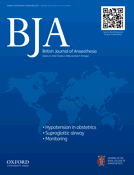
BRITISH JOURNAL OF ANAESTHESIA
Pioneering Research for Tomorrow's Anesthesia PracticesThe British Journal of Anaesthesia is a leading peer-reviewed journal published by Elsevier Science Ltd, dedicated to advancing the field of anesthesiology and pain medicine. Since its inception in 1923, this prestigious journal has served as a vital resource for clinicians, researchers, and students, providing high-quality research articles, reviews, and clinical guidelines. With an impressive impact factor and a Scopus rank of #2 out of 136 in its category, it stands out as a Q1 journal, reflecting its significance and influence in the medical community. The journal aims to disseminate innovative research findings, enhance clinical practice, and contribute to the education of healthcare professionals globally. Although it does not offer open access, its rich archive and ongoing publication in the dynamic field of anesthesiology make it an essential reference for those seeking to stay at the forefront of this critical discipline. For more information, visit the journal’s dedicated webpage.